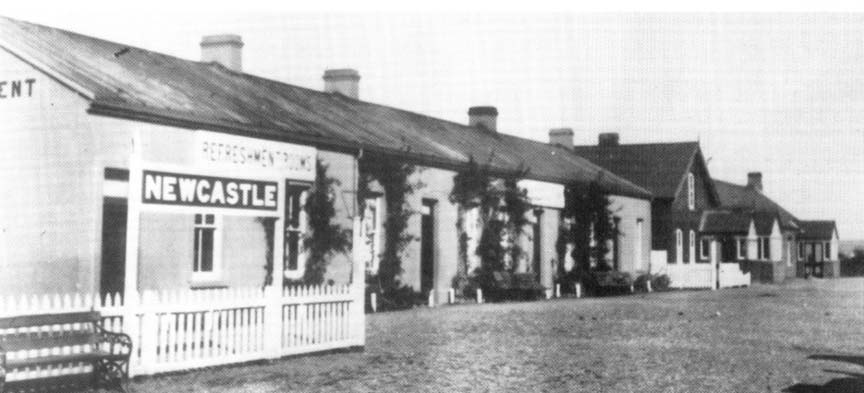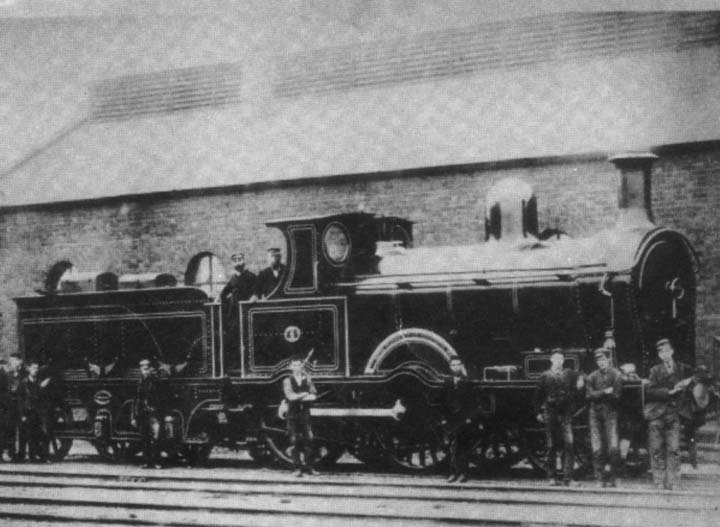|
Ros
Davies' Co.
Down, Northern Ireland Family History Research Site
© Rosalind Davies 2001 Permission granted to reprint research for non-profit use only |
The Coming of the Railway to Newcastle, Co. Down
Newcastle Railway Station was opened in 1869 and replaced in 1906. Lawrence's Tea Rooms can be seen on the left.
#6 engine which arrived in Newcastle in 1894
|
The railway age began in Ulster in 1839 with the opening of the Ulster Railway from Belfast to Lisburn. By 1842, thanks to the energetic work of the contractor, William Dargan, the line had reached Portadown. The success of the Ulster Railway led to further railways being proposed in the 1840s- the decade of railway mania in England. The lines to Holywood, Carrickfergus and to Ballymena were all operational by 1848, but the proposed railway from Belfast to Downpatrick took longer to realise. The concept of this railway was discussed in 1845 by Rev. J.R. Moore and the Marquis of Downshire, the former being naturally anxious that the neighbouring Downshire estates and the port of Dundrum would not benefit at the possible expense of the Annesley estates; "It is in contemplation to have a railway to Downpatrick to meet the Belfast one, and it is to be hoped one also to Banbridge." Mr Moore believed that Newcastle should be a terminus for the new railway and that this would enhance the potential of the harbour , being 'the same distance from Liverpool as Kingstown is." By 1850 the Belfast & County Down Railway (BCDR) had been opened for traffic as far as Comber and Newtownards, with five trains daily in each direction. Furthermore, William Dargan had been responsible for the construction of an isolated railway from Newry to the growing resort of Warrenpoint, a place which the Annesley Trustees had increasing reason to regard as a serious rival to Newcastle. Five trains a day ran on this Newry, Warrenpoint and Rostrevor Railway and three on Sundays. The progress of the County Down Railway south of Comber was slow. The terrain was difficult and many cuttings and embankments were required, so that the market- town of Ballynahinch was not reached until 1858. Three years later, in 1861, Downpatrick became a terminus, 27 miles from Queen's Quay in Belfast. By this stage serious financial problems had arisen, so a new company- the Downpatrick, Dundrum and Newcastle Railway (DDNR) was floated. This company had an initial authorised capital of £75,000, of which the County Down Railway subscribed£10,000. The first sod was turned in the construction of the new railway on 9 th November 1867 and by the following August an article in the Belfast Newsletter asserted that " the opening of the line to Newcastle, now nearly accomplished, must be very beneficial to the company; the proximity of Newcastle to Belfast and all its attractions a s a marine residence, will, within a few years, make it the favourite resort of the superior classes resident in Belfast and the towns along the Ulster Railway." Rolling stock was purchased, namely, two locomotives and tenders, ten carriages, fifteen goods wagons and one horse box. A working arrangement was agreed between DDNR and BCDR by which there would be a minimum service of two passenger trains a nd one goods train each way on weekdays and two passenger trains on Sundays. Further, the Newcastle company would provide for the operation of the stations on the line from Downpatrick Junction to Newcastle,as well as building a new station at Tullymurry for the Clough and Seaforde traffic. Finally, the line was opened to traffic, with little fuss, on 26th March 1869. The two passenger trains left Belfast at 7:30 a.m. and at 4:45 p.m. and the up trains left Newcastle at 9:45 a.m. and 6:30 p.m.. It was indicative of the enterprising spirit of the two railways that excursion tickets were issued from al stations of the County Down Railway to Newcastle and back for Easter Monday; "same day only at single fares". Special trains were also run in connection with Downpatrick steeplechases and on the days of the Down Assizes. At the half- yearly meeting of shareholders in August 1869 they were told that the results of the opening of the railway service to Newcastle had been very satisfactory; "in fact the lack of sufficient house accommodation at Newcastle had prevented the traffic reaching much larger dimensions. " One shareholder thought that the fares were too highland that there should be a reduction in the 2nd class rates. The chairman, W. R. Anketell, replied that the 1st class return fare from Belfast to Newcastle was only five shillings and furthermore that the 3rd class carriages were so superior that many who would otherwise travel 2nd class availed themselves of those carriages. In addition, he was pleased to inform the meeting that the impending opening of the Belfast Central Junction Line would enable excursion trains to be run direct to Newcastle from Armagh, Dungannon and all stops between there and the Ulster Railway terminus at Glengall Street, Belfast. Indeed, the 'Downpatrick people were already making a Brighton of Newcastle, going backwards and forwards every day." Among the teething troubles of the Newcastle railway was the complaint by the guards that they had difficulty in obtaining overnight accommodation in Newcastle. The engine crews asked the directors for an increase in the lodging allowance from 6 pence to one shilling per night. This request was accepted and the engineer, C.K. Domville, was required to look into the provision of sleeping accommodation for the trainmen in the Newcastle engine shed. Another problem arose 'in consequence of the Newcastle goods store, the roof not being properly finished, any goods therein were liable to be destroyed by the rain pouring through the slates." Then the station master at Newcastle was found to be absent from duty on 6th April and his cash was short. He 'had lately conducted his business in an unsatisfactory manner, so he was ordered to be dismissed despite his pleas for a second chance." These incidents gave some substance to the comment in Murray's 'Handbook for Travellers in Ireland'*1878) that on the Irish railways 'the stations are still more primitive than the carriages and the Station- masters and their assistants at the minor stations are curiously unsophisticated and free from the restraints of red tape." Overshadowing all these incidents was the problem of the relationship of the two railway companies. At first the directors of the BCDR were willing to recommend that their shareholders should lease the Newcastle railway at a rent of £1,000 per annum. This was followed by an offer to purchase the Newcastle line for £23,000 cash and a further payment of £10,000 when traffic reached £4,000 per annum and £12,000 as a final payment when traffic reached £5,000. These two later payments were to be made by the issue of preference shares. However, these proposals were rejected by DDNR. The County Down Railway was in financial difficulties in the period 1873-1875 and as a result there was no dividend paid on ordinary shares and preference share were £24,000 in arrears. Not surprisingly the £50 shares dropped to £10 in value, the board of directors resigned , the company's affairs were investigated and a new chairman, Richard Woods Kelly, appointed to revitalise the company. The question of charges for working the Downpatrick, Dundrum and Newcastle Railway became a bone of contention in 1877 and an arbitration settlement ruled that the Newcastle railway should pay the BCDR £2,725 per annum plus half the receipts when they exceeded £4,200 per annum. This settlement was to stand for 5 years from 1877 until 1882. However, in 1881 the BCDR purchased the DDNR for £12,000 and £38,000 in debenture stock. During the 1870s and 1880s improved railway services meant that it was possible travel on weekdays by the 10:20 a.m. from Belfast to Newcastle and back for 5 shillings 1st Class, 4 shillings in the 2nd Class and for 3 shillings and 6 pence 3rd Class. On Sundays, the corresponding fares were lower, the 3rd Class fare being a bargain at half a crown return. ( 30 pence) Of course, the County Down Railway was not alone in encouraging traffic by introducing excursion fares. The Belfast & Northern Counties Railway provided excursions to the Antrim Coast , the Donegal Highlands and a remarkable circular tout in conjunction with the Great Northern Railway, from Dublin to Londonderry via Enniskillen , returning by Portrush and Portadown Not surprisingly, tourism began to be developed in the Mournes . Passengers arriving at Newcastle could transfer to the horse-drawn mail-car to Kilkeel , arriving there in time to connect with the mail coach to Newry at 6:00 p.m.. In addition to the mail service, Dorans car's departed from Kilkeel every morning at 7:15 a.m. for Warrenpoint. There the travellers might well stay at the Royal Hotel, an inn which boasted for having 'good vehicles and horses, with steady drivers.' Nearby at Rostrevor was the Mourne Hotel, which like the Bellvue in Newcastle, was owned by Messrs. Norton & Co. Not only did Norton's advertise 'steam, sailing and rowing boats in connection with the Hotel' but their coach services linked Newcastle effectively with the tourist circuit of the Kingdom of Mourne. This also served to increase competition from the established resorts of Warrenpoint and Rostrevor, but after the formation of the Great Northern Railway in 1876, meant a potential threat to the traffic on the County Down Railway. On the other hand, Newcastle benefited by ceasing to be a terminus and becoming one of the resorts on the circular tour of the Mournes, an excursion which began to attract tourists from Belfast as well as Dublin. by Grenfell Morton; Reprinted from Victorian & Edwardian Newcastle |
Click here
to return to railway articles in Down Recorder newspaper
Click here
to view old photos of various railway stations
Click
here to view various railway timetables, excursion brochures &
a prospectus
Click here
to see map of the Great Northern Railway
Click here
to see a map of BCDR lines

